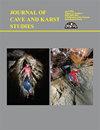Preliminary estimates of dinosaur size and speed at the Early Cretaceous Clayton Lake dinosaur tracksite, Union County, New Mexico
IF 0.5
4区 地球科学
Q4 GEOSCIENCES, MULTIDISCIPLINARY
引用次数: 1
Abstract
The Early Cretaceous (late Albian) dinosaur tracksite at Clayton Lake in Union County encompasses approximately 533 dinosaur tracks, 182 of which are organized into 28 trackways. Most of the trackways were made by bipedal ornithopod dinosaurs, but two trackways were made by bipedal theropods, and one was made by a quadrupedal ankylosaur. To estimate dinosaur speeds from the trackways, we employed the methods of Alexander (1976, 1989) and Thulborn (1990) that rely on footprint lengths and strides as the raw data from which to estimate size and speed. On the Clayton tracks, we measured total length and width as highest edge to highest edge (rim to rim) of the maximum track shape. Though not ideal, this approach was dictated by the quality and nature of track preservation and provided a consistent methodology. For deeper tracks, these measurements are similar to the “negative vertical displacement” approach, but less than the “maximum zone of deformation.” This approach neither captures the true footprint dimensions nor the full extent of extramorphological variation but does represent the maximum lengths and widths on the bedding plane surface. Track length was measured from the anterior tip of digit III to the base of the “heel” margin, actual or inferred. In some cases, our measured track lengths exceed the true foot length of the trackmaker, and these tracks are unsuitable for size and speed estimates. However, some trackways have a “best” track(s) that exhibit(s) some combination of clear track outline, high angle footwalls, and “impressed” positives. We estimated size and speed for these. The results (using the method of Alexander, 1976) are that all of the ornithopod trackways show walking speeds of ~ 2-to 7 km /hour. The relatively fastest dinosaur speed at Clayton Lake may be新墨西哥州联合县早白垩纪克莱顿湖恐龙足迹遗址对恐龙大小和速度的初步估计
位于联合县克莱顿湖的早白垩纪(阿尔比安晚期)恐龙足迹遗址包含了大约533条恐龙足迹,其中182条被组织成28条足迹。大多数脚印是由两足鸟脚亚目恐龙留下的,但有两条脚印是由两足兽脚亚目恐龙留下的,还有一条是由四足甲龙留下的。为了从轨道上估计恐龙的速度,我们采用了Alexander(1976年,1989年)和Thulborn(1990年)的方法,这些方法依靠足迹长度和步幅作为原始数据来估计恐龙的大小和速度。在克莱顿轨道上,我们测量了最大轨道形状的最高边缘到最高边缘(边缘到边缘)的总长度和宽度。虽然不理想,但这种方法是由轨道保存的质量和性质决定的,并提供了一致的方法。对于更深的轨道,这些测量类似于“负垂直位移”方法,但小于“最大变形区”。这种方法既没有捕捉到真实的足迹尺寸,也没有捕捉到外变质变化的全部范围,但却代表了层理平面表面的最大长度和宽度。径迹长度测量从趾III的前尖端到“脚跟”边缘的底部,实际或推断。在某些情况下,我们测量的履带长度超过了履带制造商的真实英尺长度,这些履带不适合估计尺寸和速度。然而,一些赛道有“最佳”的赛道,展示了清晰的赛道轮廓,高角度的下坡和“令人印象深刻”的优点。我们估计了它们的大小和速度。结果(使用Alexander, 1976年的方法)显示,所有的鸟脚亚目动物的行走速度为每小时2至7公里。克莱顿湖相对最快的恐龙速度可能是
本文章由计算机程序翻译,如有差异,请以英文原文为准。
求助全文
约1分钟内获得全文
求助全文
来源期刊

Journal of Cave and Karst Studies
地学-地球科学综合
CiteScore
1.90
自引率
0.00%
发文量
6
审稿时长
>12 weeks
期刊介绍:
The Journal of Cave and Karst Studies is a multidisciplinary journal devoted to cave and karst research. The Journal is seeking original, unpublished manuscripts concerning the scientific study of caves or other karst features. Authors do not need to be members of the National Speleological Society, but preference is given to manuscripts of importance to North American speleology.
 求助内容:
求助内容: 应助结果提醒方式:
应助结果提醒方式:


